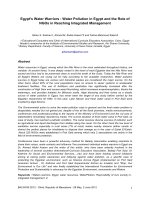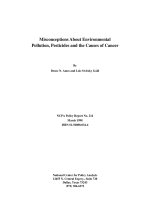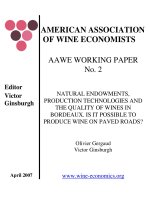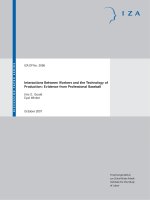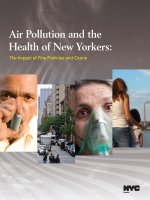- Trang chủ >>
- Khoa Học Tự Nhiên >>
- Vật lý
charles babbage and the engines of perfection jan 1999
Bạn đang xem bản rút gọn của tài liệu. Xem và tải ngay bản đầy đủ của tài liệu tại đây (963.09 KB, 128 trang )
Charles Babbage and the
Engines of Perfection
Bruce Collier
James MacLachlan
Oxford University Press
Charles Babbage
and the Engines of Perfection
Image Not Available
Charles Babbage
and the Engines of Perfection
Bruce Collier and James MacLachlan
Oxford University Press
New York • Oxford
CIENCE
PORTRAITS
XFORD
S
IN
Owen Gingerich
General Editor
Oxford University Press
Oxford New York
Athens Auckland Bangkok Bogotá Buenos Aires
Calcutta Cape Town Chennai Dar es Salaam
Delhi Florence Hong Kong Istanbul Karachi
Kuala Lumpur Madrid Melbourne Mexico City
Mumbai Nairobi Paris São Paulo Singapore
Taipei Tokyo Toronto Warsaw
and associated companies in
Berlin Ibadan
Copyright © 1998 by Bruce Collier and James MacLachlan
Published by Oxford University Press, Inc.,
198 Madison Avenue, New York, New York 10016
Oxford is a registered trademark of Oxford University Press
All rights reserved. No part of this publication
may be reproduced, stored in a retrieval system, or transmitted,
in any form or by any means, electronic, mechanical,
photocopying, recording, or otherwise, without the prior
permission of Oxford University Press.
Design: Design Oasis
Layout: Leonard Levitsky
Picture research: Lisa Kirchner
Library of Congress Cataloging-in-Publication Data
Collier, Bruce.
Charles Babbage and the engines of perfection / Bruce Collier and
James MacLachlan
p. cm. — (Oxford portraits in science)
Includes bibliographical references and index.
1. Babbage, Charles, 1791–1871—Juvenile literature.
2. Mathematicians—England—Biography—Juvenile literature.
3. Computers—History—Juvenile literature. [1. Babbage, Charles,
1791–1871. 2. Mathematicians.] I. MacLachlan, James H. 1928– .
II. Title. III. Series
QA29.B2C65 1998
510’.92—dc21 98-17054
[B] CIP
ISBN 0-19-508997-9 (library ed.)
9 8 7 6 5 4 3 2 1
Printed in the United States of America
on acid-free paper
On the cover: The frontispiece of the October 1832–March 1833 issue of Mechanics
Magazine; inset: Babbage in 1860.
Frontispiece: Charles Babbage in 1829 as the Lucasian professor of mathematics at
Cambridge University.
Contents
Chapter 1: The Making of a Mathematician . . . . . . . . . . . . . . .8
Chapter 2: In Scientific Circles . . . . . . . . . . . . . . . . . . . . . . . . .20
Sidebar: Logarithms Explained . . . . . . . . . . . . . . . . . . . . . . .32
Chapter 3: Inventing the Difference Engine . . . . . . . . . . . . . .35
Sidebar: Differences in Sequences of Numbers . . . . . . . .39
Sidebar: Early Mechanical Calculators . . . . . . . . . . . . . . . . .44
Chapter 4: Reform Is in the Air . . . . . . . . . . . . . . . . . . . . . . . .49
Sidebar: The Operation of the Jacquard Loom . . . . . . . . .66
Chapter 5: Inventing the Analytic Engine . . . . . . . . . . . . . . . . .73
Chapter 6: Passages in a Philosopher’s Life . . . . . . . . . . . . . . .92
Chapter 7: After Babbage . . . . . . . . . . . . . . . . . . . . . . . . . . . .104
Museums and Web Sites Related to Charles Babbage . . . .112
Chronology . . . . . . . . . . . . . . . . . . . . . . . . . . . . . . . . . . . . . . . .115
Further Reading . . . . . . . . . . . . . . . . . . . . . . . . . . . . . . . . . . . .119
Index . . . . . . . . . . . . . . . . . . . . . . . . . . . . . . . . . . . . . . . . . . . . .121
This page intentionally left blank
Charles Babbage
Alexander Graham Bell
Nicolaus Copernicus
Francis Crick
& James Watson
Marie Curie
Charles Darwin
Thomas Edison
Albert Einstein
Michael Faraday
Enrico Fermi
Benjamin Franklin
Sigmund Freud
Galileo Galilei
William Harvey
Joseph Henry
Edward Jenner
Johannes Kepler
Othniel Charles Marsh
& Edward Drinker Cope
Gregor Mendel
Margaret Mead
Isaac Newton
Louis Pasteur
Linus Pauling
Ivan Pavlov
CIENCE
PORT RAITS
XFORD
S
IN
This watercolor miniature of Charles Babbage is one-half of a locket that also contains a portrait of his fiancée
Georgiana Whitmore. The two were married in 1814.
Image Not Available
The two young friends were poring over columns of num-
bers. Two sets of clerks had calculated values for the posi-
tions of a number of stars as seen at regular times through
the year. Now, the young men had to compare these results.
As the number of errors mounted, they found the task
increasingly tedious. Gentlemen of science, recent graduates
of Cambridge University, Charles Babbage and John
Herschel thought there had to be a better way.
“I wish to God these calculations could be done by a
steam engine,” Babbage complained. Herschel replied that
he thought it might be possible. Babbage let the idea roll
around in his mind for the next few days. Soon, he decided
that not only was it possible, but he could do it.
This occurred late in 1821. By June of 1822, Babbage
had constructed a small model of a calculating machine. He
announced his success to the Royal Astronomical Society in
London:
I have contrived methods by which type shall be set up by
the machine in the order determined by the calculation.
The arrangements are such that . . . there shall not exist the
possibility of error in any printed copy of tables computed
by this engine.
9
The Making of a
Mathematician
CHAPTER
1
Thus launched, Charles Babbage devoted many years of
his long and productive life to the realization of his dream
of mechanical calculations. Ultimately, his machine was
abandoned. Although his principles were sound, the time
and cost of construction proved greater than Babbage could
afford. The government, which initially provided financial
support, was unwilling to complete the project.
Charles Babbage was born in south London on
December 26, 1791. His father, Benjamin, was a successful
banker from Totnes in Devon (in southwest England).
Benjamin had waited until he was 38 year of age and
wealthy before marrying and moving to London to join a
new banking firm. His wife, Elizabeth (Betty) Plumleigh
Teape, was seven years his junior. Charles was born a year
or so after their marriage. Later, two other sons died in
infancy. A daughter, Mary Anne, was born in 1798. She
outlived Charles and the two siblings remained close
throughout their lives.
As a child, Charles displayed a great curiosity about
how things worked. With each new toy, he would inquire,
“Mamma, what is inside of it?” Often, if he was not satis-
fied with the answer, he would break open the toy to see
for himself. Once, his mother took him to see an exhibition
of machinery in London. Charles showed so much interest
in one exhibit that the artisan took him to his workshop.
There, the boy was fascinated to see a foot-high silver fig-
urine dancing on a stand and holding a bird that flapped its
wings and opened its beak. Though Charles was curious
about the mechanism within, he did not break open this
toy. However, many years later, he purchased the figurine at
an auction. He restored it to working order and proudly
demonstrated its antics in his drawing room.
At age ten, Charles suffered from violent fevers. In that
time before modern drugs and innoculations, his parents
feared for his life. Hoping that country living would
improve his health, they sent him to a school in Devon near
10
Charles Babbage
Totnes. The schoolmaster was asked to attend to his health,
but not to press too much knowledge on him. In later life,
Babbage wrote that this mission was “faithfully accom-
plished. Perhaps great idleness may have led to some of my
childish reasonings.” One of his childish reasonings involved
performing experiments to see if devil-worship incantations
actually worked. For him, at least, they did not.
By 1803, Benjamin Babbage had amassed sufficient
capital to retire. With his wife and daughter, he returned to
Totnes. At the same time, in improved health, Charles was
sent to a small residential school in the village of Enfield
near London, where he remained for three years. The
teacher at Enfield was Stephen Freeman, an amateur
astronomer. He awakened Charles’s interest in science and
mathematics. Yet Babbage’s mathematical skills were largely
self-taught from books he found in the school’s modest
library. In his second year at Enfield, Charles and another
boy began getting up every day at 3
A.M. to study algebra.
When Freeman learned of this several months later, he
made them stop. However, Babbage thought highly enough
of Freeman’s school that he later sent
two of his own sons there for a time.
Charles then moved to a small
school near Cambridge for a couple
of years. This may have been to pre-
pare for entrance to the University
of Cambridge, but it made little
impression on him. At age 16 or 17,
Babbage returned to Devon to live
with his parents. He learned Latin
and Greek with a tutor and also
spent much time studying mathe-
matics on his own. By then, he was
passionately fond of algebra and
devoured every book he could find
on the subject.
11
The Making of a Mathematician
Trinity College, Cambridge,
was founded in 1546. This
was the college of Isaac
Newton and Charles
Babbage, both of whom
also held the Lucasian
chair of mathematics at
Cambridge.
Image Not Available
In the fall of 1810, Charles Babbage enrolled at Trinity
College, Cambridge. This was the university of Isaac
Newton, inventor of calculus and the theory of gravitation.
Babbage looked forward to receiving a first-rate training in
mathematics, but was destined to be greatly disappointed.
For a century after Newton’s tenure, Cambridge had
advanced very little beyond him in the study of mathemat-
ics. In fact, almost all advances since Newton had been
made by French and Swiss mathematicians. These men fol-
lowed a style of calculus invented about the same time as
Newton’s by a German, Gottfried Leibniz. Although the
two had invented the calculus independently, the English
claimed Leibniz had stolen his ideas from Newton.
12
Charles Babbage
Sir Godfrey Kneller, the
most popular portrait
painter of his time,
produced the first
portrait of Sir Isaac
Newton in 1689, when
Newton was 46.
Image Not Available
Calculus provides a way to calculate changing quanti-
ties, for example, to find the changing speed of a jet of
water from a hole in a barrel as the water level in the barrel
decreases. Newton thought of the quantities as being in
flux, and called his technique the study of fluxions. Leibniz,
on the other hand, thought of the successive differences as a
quantity changed, and called his technique the study of dif-
ferentials. Also, the two men differed in the way they sym-
bolized the changing quantities; that is, they had different
mathematical notations.
Babbage was keen to be up-to-date in mathematics
when he got to Cambridge. Having an annual allowance
from his father of £300, Charles decided that, on his way
from Devon to Cambridge, he could stop in London and
splurge on the best calculus textbook available, which was a
three-volume work by the French mathematician
Sylvestre-François Lacroix. He expected it to cost £2
(about a third of a week’s allowance) but discovered that
13
The Making of a Mathematician
The Method of
Fluxions and Infinite
Series is one of three
mathematical works by
Newton that are the
basis for the historical
claims of his priority over
Leibniz as the inventor
of calculus.
Image Not Available
England’s war with Napoleon had driven up the price of French
books. So, he paid out the £7 that the bookseller demanded. He
would just have to buy less wine for a few weeks.
Once settled in Cambridge, Charles plunged into his
new book. Soon, he ran into some mathematical reasoning
he could not understand. He took the problem to his
assigned tutor, John Hudson. After listening to the question,
Hudson told Babbage that such a question would never be
asked on any of his university exams, and he would do bet-
ter to spend his time on the kinds of questions that would.
Another Cambridge tutor, Robert Woodhouse, had writ-
ten books on the newer style of mathematics, but they had lit-
tle influence. An English review of one of Woodhouse’s books
criticized it unmercifully:
14
Charles Babbage
Gottfried W. Leibniz,
philosopher, math-
ematician, and historian,
was also a member of
the royal court at the
house of Hanover in
Germany. When the
Elector of Hanover
became King George I
of England, Newton
(Leibniz’s arch-rival) per-
suaded the king not to
bring Leibniz to London.
Image Not Available
Mr. Woodhouse’s quitting the fluxionary notation of Sir
Isaac Newton for the differential one of Leibniz, who,
though a man of eminent and diversified talents, was cer-
tainly a plagiarist in matters of science, strikes us as a
ridiculous piece of affectation. The two calculuses differ
only in name and in notation, which in fluxions is equal,
at least in simplicity to that of differentials, and unques-
tionably superior to it in point of conciseness. As this is the
case, and as the Royal Society of London took a great deal
of pains to have Sir Isaac’s claim to the invention investi-
gated and established, we trust the principal mathemati-
cians in this island will never think of abandoning the
notation of the inventor for the other.
This came 90 years after the dispute between Newton
and Leibniz. It neglected to mention that Newton himself
had written the indictment of Leibniz’s calculus!
Babbage quickly realized that, if he wanted to become
a mathematician, he would have to continue to study on
his own. He would get no help from his teachers.
Evidently, the Cambridge faculty were so dazzled by
Newton’s achievements that they felt incapable of surpass-
ing them in any respect even though Cambridge prided
itself on the quality of its mathematics education. Indeed,
all England recognized a Cambridge degree in mathematics
as the unexcelled preparation for professional life, whether
in law, medicine, or theology. Yet, the examinations did not
test mathematical competence as much as they did the stu-
dents’ capacity to memorize set pieces taken from the
works of Newton. As far as Babbage could see, they were a
hundred years out of date.
It was not long before Babbage decided he had to do
something about that. During his second year at Cam-
bridge, Babbage jokingly suggested to a friend that they
should have a society to promote Lacroix’s textbook among
their fellow students. This was because another student
group had just been formed to promote the reading of the
Bible. Babbage drew up a small poster on behalf of
15
The Making of a Mathematician
Lacroix’s book as a parody of the posters the Bible Society
had plastered around Cambridge. But his friend took him
seriously, and a few days later, a dozen students met to
found the Analytical Society.
The Analytical Society held monthly meetings during
school terms from 1812 to 1814. Some of the society’s work
was published in a small book in 1813. However, its most
productive result was the publication of two books on the
calculus of differentials. The first was a translation of part of
Lacroix’s work by Babbage and two friends that appeared in
1816. Four years later, the same three men produced a
two-volume set of examples of problems in the calculus.
Babbage’s two friends were John Herschel and George Peacock.
16
Charles Babbage
Sir John Frederick William
Herschel, a life-long
friend of Babbage, was
an astronomer like his
father, who discovered
the planet Uranus.
Besides creating a map
of the southern sky from
Cape Province in Africa,
John Herschel was also a
pioneer in photography.
Image Not Available
Herschel was the son of William Herschel, the outstanding
astronomer who had discovered the planet Uranus in 1781.
John followed in his father’s footseteps, and became one of
the leading men of science in England during the 1800s. He
and Babbage became lifelong friends, and Babbage named his
firstborn son Herschel. George Peacock spent most of the
rest of his life at Cambridge as a mathematics tutor. He
became a force in reforming the mathematics curriculum
there, although it took many years to accomplish.
Babbage made other lifelong friends among the mem-
bers of the Analytical Society. One was Edward Bromhead,
after whom Charles named another son. Bromhead inherit-
ed his father’s estates in Lincolnshire, and spent most of his
life managing them. Another friend was Edward Ryan,
who became chief justice for the state of Bengal in India.
You should not suppose that Babbage spent all his time
on mathematics. He was, in fact, a popular and gregarious
student, with friends of widely ranging interests. He met
one group for breakfast every Sunday morning to discuss
many philosophical issues, such as the meaning of life and
death. With another group, he often sailed on the river
Cam in his own boat. These friends were chosen not for
their intellect but for their ability to row the boat when the
wind dropped. Babbage was also a keen player of table
games—chess and whist, which is a card game like bridge.
Babbage was also interested in chemistry. He set up one of
his rooms as a laboratory, where he conducted experiments,
often assisted by John Herschel.
To get some idea of Babbage’s lifestyle, one needs to
convert the currency of his time into present-day values.
For a rough comparison, consider that £1 (one pound ster-
ling) in the early 1800s is equivalent to about $200 at the
end of the 1900s. So Babbage’s allowance of £6 per week
would represent about $1200 today—not too shabby. Of
course, prices then were not the same as today. Generally,
manufactured goods were more expensive; the necessities of
17
The Making of a Mathematician
life were cheaper. The wage of an ordinary clerk or laborer
in England at that time was about £1 per week. These
working poor managed to raise their families on such an
income. Commodity prices were so low that £1 would buy
50 pounds of meat.
Babbage’s weekly expenditure might well have been
greater than £6, because he spent his summers at home in
Devon. Presumably, his father did not charge him room and
board then. In the summer of 1812, Babbage and his friend
Edward Ryan met the two youngest of the eight Whitmore
sisters, whose home was in Shropshire. Romance blos-
somed, and before the summer ended, Charles was engaged
to Georgiana Whitmore, who was just a year younger than
he. Ryan became engaged to her sister, Louisa.
For many Cambridge students, the most important
activity was preparing for the examinations. Obtaining high
honors was the surest way to gain good employment. A stu-
dent guide of the period advised that having numerous
friends was the best way to waste time. It also deplored as
“the first step to idleness and folly, the reading of books you
think are suitable instead of those recommended by your
tutor.” This was advice Charles Babbage did not follow.
According to one of his tutors, Charles did not care to be
ranked and wished only for his tutors to be aware that he
knew the work. Moreover, this tutor remarked,“he would
not compete for mathematics honors on taking his degree,
though I believe that if he had, he could easily have taken
first place.” The summer after he graduated, Charles wrote
to John Herschel a direct contradiction of the student
guide’s advice:
There are two reasons for which I shall always value a
university education—the means it supplied of procuring
access to books—and the still more valuable opportunities
it affords of acquiring friends. In this latter, I have been
singularly fortunate. The friendships I have formed while
18
Charles Babbage
there I shall ever value; nor do I consider my
acquaintance with yourself as one of the
least advantages.
Babbage graduated at Cambridge in
the spring of 1814. Against his father’s
wishes, Charles married Georgiana
Whitmore in July. Benjamin Babbage
had no complaints against Georgiana.
His attitude was that, like himself,
Charles should wait until he was properly
established financially. The young couple
honeymooned in a charming village in
Devon. From there, Babbage wrote a letter
describing his situation to John Herschel, and
then went on to include some mathematical theorems
he had been working on. Herschel was appalled. He
replied to Charles: “‘I am married and have quarreled with
my father’—Good God Babbage—how is it possible for a
man calmly to sit down and pen those two sentences—and
then to pass on to functional equations?”
The newlyweds spent a long romantic summer in the
Devon countryside. In the fall, they moved to London.
Despite his father’s urgings, Charles had no job and few
prospects. Fortunately, Benjamin continued his £300 annu-
al allowance, to which Georgiana could add £150 of her
own. With such an income, the couple could maintain a
modest life without lavish entertaining.
19
The Making of a Mathematician
Georgiana Whitmore
married Charles Babbage
in 1814 while Charles
was still an undergradu-
ate at Cambridge
University.
Image Not Available
In Scientific Circles
Charles and Georgiana Babbage moved to London in the
autumn of 1814. After a few months in various quarters,
they moved into a small, comfortable house in the
Marylebone district just south of Regent’s Park in London’s
northwest. The previous month, on August 6, 1815,
Georgiana had given birth to Benjamin Herschel Babbage,
who was always called by his second name. Other children
were born at approximately two-year intervals: Charles Jr.,
Georgiana, two sons who did not survive infancy, Dugald
Bromhead, and Henry Prevost.
These early years in London were generally happy. The
Babbages often visited with friends and relatives in other
parts of England. Normally, they spent the summer months
in Devon, with side trips to Shropshire to visit the Whit-
mores. Charles was a somewhat grim and distant father,
though he tried to overcome his experiences with his own
father. He described his father to his friend John Herschel
in a letter:
He is stern, inflexible and reserved, perfectly just, some-
times liberal, never generous. [He has] a temper the most
horrible that can be conceived. A tyrant in his family, his
CHAPTER
2
20
Image Not Available
In 1814, newlyweds Charles and Georgianna Babbage moved to the Marylebone district, just south of London’s
fashionable Regent’s Park. Here, ice skaters take advantage of the park’s frozen pond in the 1830s.
Image Not Available
presence occasions silence and gloom. . . . Tormenting
himself and all connected with him, he deserves to be mis-
erable. Can such a man be loved? It is impossible.
This was Charles’s model for fatherhood. Perhaps he may be
forgiven if he sometimes fell short of the higher expecta-
tions he tried to fulfill for himself as a father. As children,
the two younger boys were in considerable awe of their
father; however, in later life, Henry was his father’s friendly
assistant for a time.
For a while, Charles sought paid employment, to prove
to his father that he could make something of himself. In
1816, he applied for the post of math professor at a college a
few miles north of London. It paid a salary of £500. He had
strong letters of recommendation from two outstanding men.
However, he was told that he would not get the job because
he lacked influence with the board of directors. Three years
later, again with strong recommendations from eminent
mathematicians, he missed a post in Edinburgh because that
job went to a Scot. Indeed, Babbage’s spirit of independence
would not make it easy for him to gain any employment.
With a barely comfortable income from their parents,
Charles and Georgiana managed. Charles continued to
work on the mathematical topics he had studied in
Cambridge. In addition, he set up a workshop in one of his
rooms to explore interesting experiments in chemistry and
mechanics. Also, he began to make himself known to the
scientific bright lights in London. John Herschel lived near-
by and introduced Babbage into scientific circles. The
Herschels, father and son, sponsored Charles’s membership
in the Royal Society. Founded in 1662, the Royal Society
was England’s major scientific insitution. Isaac Newton had
been its president from 1702 to 1727.
The Royal Society published a monthly journal of sci-
entific papers. From time to time it also supported scientific
expeditions abroad. Charles published a 111-page essay on
calculus in the Philosophical Transactions of the Royal Society in
22
Charles Babbage
1815–16. Also through the Herschels’ influence, Charles
was asked to present a series of lectures to the Royal
Institution in London in 1816. Founded in 1800, the Royal
Institution was both a research lab and a public forum for
science. Its director, Humphrey Davy, conducted important
chemical research and discovered several new elements. His
successor, Michael Faraday, would later do important work
in electromagnetism. Both those men gave outstanding
popular lectures on science to the cream of London society.
Charles’s lecture series was well received. It demonstrated
his capacities as a scientist and put him into the center of
London society, both scientific and otherwise.
Besides social visits with his family, Charles Babbage
also frequently traveled abroad for scientific purposes. In
1819, he and John Herschel went to Paris to visit its eminent
23
In Scientific Circles
Pierre S. La Place, a
French mathematician,
has been called the
Isaac Newton of France.
He wrote an important
work on celestial
mechanics, and also
helped to found studies
of probability theory and
thermochemistry.
Image Not Available
scientists. Among others, they met and became friendly
with Pierre Laplace, Claude Berthollet, Jean Fourier, Jean
Biot, and François Arago. Laplace was a theoretical
astronomer who did much to extend and deepen Newton’s
analysis of the planetary system. Laplace had also held high
office in Napoleon’s government. Babbage remarked that no
scientist would expect to achieve that status in England.
Berthollet, an eminent chemist, was active in the improve-
ment of industrial processes such as the dyeing of fabrics.
Fourier was an outstanding mathematical physicist. Babbage
recorded that “his unaffected and genial manner, and his
admirable taste conspicuous even in his apartments, were
most felt by those who were honored by his friendship.”
Biot was a balloonist, and an active investigator of phe-
nonomena of light, electricity, and magnetism. Late in Biot’s
life, Babbage visited him, inquiring of a servant if his health
could stand the visit. From his bedroom, Biot heard the
remark and came out into the hall say-
ing, “My friend, I would see you even
if I were dying.” The physicist François
Arago was a co-worker of Biot’s, and
also active in the governments of his
day. His work was recognized by the
Royal Society of London, which gave
him its Copley Medal in 1825.
Babbage and Herschel returned to
London full of admiration for the way
science was organized in France and
impressed by the influence scientists
had with their government. They felt
there was a lot of room for improve-
ment in England. One result of those
feelings developed early in 1820. The
two young men were discontented
with the state of the Royal Society. It
seemed to them to be much more a
24
Charles Babbage
Jean B. Biot, a French physi-
cist, studied polarization of
light, the magnetic effects
of electricity, and the flow
of heat in solids.
Image Not Available


